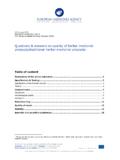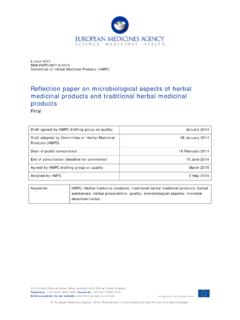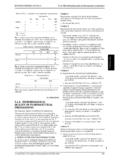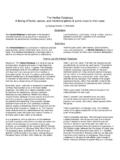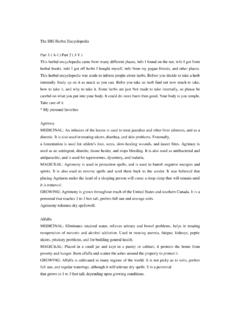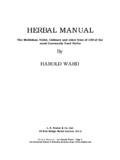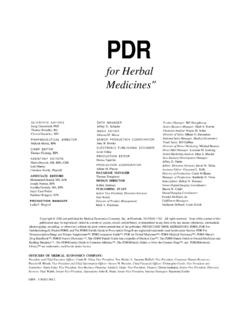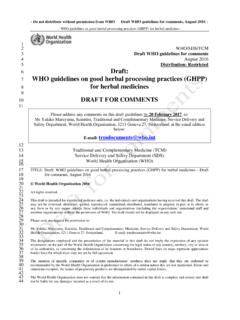Transcription of WHO monographs on selected medicinal plants
1 WHO monographs on selected medicinal plants Volume 4. WHO. monographs on selected medicinal plants VOLUME 4. WHO Library Cataloguing-in-Publication Data WHO monographs on selected medicinal plants . Vol. 4. 1. plants , medicinal . 2. Angiosperms. 3. Medicine, Traditional. I. WHO Consultation on selected medicinal plants (4th: 2005: Salerno-Paestum, Italy) II. World Health Organization. ISBN 978 92 4 154705 5 (NLM classi cation: QV 766). World Health Organization 2009. All rights reserved. Publications of the World Health Organization can be obtained from WHO Press, World Health Organization, 20 Avenue Appia, 1211 Geneva 27, Switzerland (tel.)
2 : +41 22 791 3264;. fax: +41 22 791 4857; e-mail: Requests for permission to reproduce or translate WHO publications whether for sale or for noncommercial distribution should be addressed to WHO. Press, at the above address (fax: +41 22 791 4806; e-mail: The designations employed and the presentation of the material in this publication do not imply the expression of any opinion whatsoever on the part of the World Health Organization concerning the legal status of any country, territory, city or area or of its authorities, or concerning the delimitation of its frontiers or boundaries.)
3 Dotted lines on maps represent approximate border lines for which there may not yet be full agreement. The mention of speci c companies or of certain manufacturers' products does not imply that they are endorsed or recommended by the World Health Organization in preference to others of a similar nature that are not mentioned. Errors and omissions excepted, the names of proprietary products are distinguished by initial capital letters. All reasonable precautions have been taken by the World Health Organization to verify the information contained in this publication.
4 However, the published material is being distributed without warranty of any kind, either expressed or implied. The responsibility for the interpretation and use of the material lies with the reader. In no event shall the World Health Organization be liable for damages arising from its use. Printed in Spain Contents Acknowledgements v Introduction 1. General technical notices 5. monographs (in alphabetical order of plant name). Fructus Agni Casti 9. Cortex Berberidis 30. Gummi Boswellii 48. Semen Cardamomi 61. Fructus Chebulae 71. Semen Cucurbitae 83.
5 Folium Cynarae 92. Cortex Granati 108. Pericarpium Granati 117. Folium Guavae 127. Lichen Islandicus 140. Fructus Macrocarponii 149. Cortex Magnoliae 167. Herba Millefolii 179. Fructus Momordicae 192. Fructus Myrtilli 210. Radix Panacis Quinquefolii 226. Cortex Phellodendron 244. Rhizoma Picrorhizae 258. Oleum Ricini 271. Aetheroleum Rosmarini 284. Folium Rosmarini 294. Cortex Salicis 309. Fructus Tribuli 323. Flos Trifolii 335. iii Contents Ramulus cum Uncis Uncariae 353. Cortex Viburni Prunifolii 364. Radix Withaniae 373. Annex 1. Participants of the Fourth WHO Consultation on selected medicinal plants Salerno-Paestum, Italy, 3 6 October 2005 392.
6 Annex 2. Cumulative index (in alphabetical order of plant name) 395. Annex 3. Cumulative index (in alphabetical order of plant material of interest) 397. Annex 4. Cumulative index of medicinal plants (in alphabetical order of Latin binomial plant name) 400. Annex 5. Cumulative index of major chemical constituents (by compound name in alphabetical order) 406. Annex 6. Cumulative index of major chemical constituents (ordered by CAS number) 430. Annex 7. Cumulative index of major chemical constituents (ordered by molecular formula) 437. iv Acknowledgements Special acknowledgement is due to Professor Norman R.
7 Farnsworth, Professor Harry Fong, and Professor Gail B. Mahady of the WHO. Collaborating Centre for Traditional Medicine, College of Pharmacy, University of Illinois at Chicago, Chicago, IL, USA, for drafting and re- vising the monographs . Special acknowledgement is also due to Dr Ray- mond Boudet-Dalbin of the Laboratoire de Chimie Th rapeutique, Uni- versity of Ren Descartes, Paris, France, for drawing the chemical structures and for compiling the index of major chemical constituents in- cluding information on their molecular formula and CAS numbers.
8 The photograph for the front cover was kindly provided by the Research Center for medicinal Plant Resources, National Institute of Biomedical Innovation, Tsukuba City, Japan. WHO also acknowledges with thanks the valuable work of the ap- proximately 200 experts including 81 national health authorities, who provided comments and advice on the draft texts; those who submitted comments through the World Self-Medication Industry (a nongovern- mental organization in of cial relations with WHO) and the Internation- al Federation of Pharmacists (a nongovernmental organization in of cial relations with WHO); and those who participated in the Fourth WHO.
9 Consultation on selected medicinal plants held in Salerno-Paestum, Italy, in October 2005 to review the monographs (see Annex 1). Sincere appreciation is extended to the Ministry of Health of Italy, the Government of the Province of Campagna, Italy, the Municipal Govern- ment of Salerno, Italy, and the State University of Salerno, who hosted the above-mentioned Fourth WHO Consultation and supported it nancial- ly. Finally, WHO wishes to express thanks to Mr Raymond Tsai, Boston, USA, Dr Hermann Garden, Basel, Switzerland, Ms Lynn Morra, Abu Dhabi, United Arab Emirates, and Ms Tina Lu, Rochester, USA, for their indispensable assistance in nalizing and editing the manuscripts.
10 V Introduction Increasing role of the WHO monographs on selected medicinal plants Over the past two decades, there has been a tremendous increase in the use of herbal medicine; however, there is still a signi cant lack of research data in this eld. Therefore since 1999, WHO has published three vol- umes of the WHO monographs on selected medicinal plants : volume 1. includes 28 monographs ; volume 2 contains an additional 30 monographs ;. and volume 3 provides 31 monographs . Including the 28 new monographs published in this volume, a total of 118 monographs in four volumes are now available on the WHO web site ( en/m/abstract/Js14213e/).










